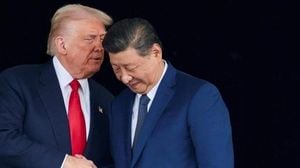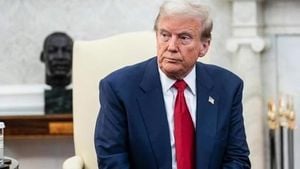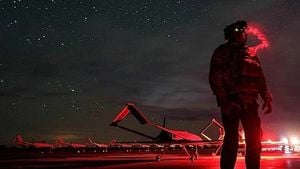President Donald Trump’s recent announcement that the United States will "start testing nuclear weapons on an equal basis" with Russia and China has sent shockwaves through the international community, reigniting memories of the Cold War and raising fresh concerns about the future of global arms control. Delivered just before his scheduled meeting with Chinese leader Xi Jinping in South Korea on November 1, 2025, Trump’s statement has been interpreted in multiple ways—either as a signal of renewed missile trials or, more alarmingly, as a potential resumption of live nuclear warhead detonations for the first time since 1992.
The ambiguity of Trump’s declaration has left both allies and analysts scrambling for answers. When pressed aboard Air Force One to clarify whether he meant actual nuclear explosions, Trump simply responded, "You’ll find out very soon, but we’re going to do some testing, yeah. Other countries do it. If they’re going to do it, we’re going to do it." According to GLOBSEC’s Tomáš Nagy, this statement might be more about pre-summit signaling or a rhetorical response to Russia’s recent nuclear-capable system tests than a concrete policy shift. "It might rather be understood in a broader context as pre-meeting signalling ahead of the Trump-Xi summit, or as a rhetorical reaction to Russia’s recent nuclear-capable system tests," Nagy explained.
Yet, the timing was deliberate. Russia had just announced successful tests of a nuclear-powered cruise missile and an underwater drone, while Trump was en route to meet with Xi. This mix of posturing and provocation has raised questions about whether the United States is genuinely considering a return to underground nuclear detonations, or if the president’s words amount to political theater designed to project strength before rivals.
Part of the confusion stems from the term "testing" itself. In nuclear parlance, it can refer either to detonating a warhead or to testing its delivery system—such as missiles. Nagy pointed out that the latter is more likely: "Nuclear weapons consist of both the warhead and its delivery vehicle. Testing could therefore refer not to a nuclear explosive test, but to missile systems such as additional Minuteman or Trident trials. All of these would carry symbolic, not explosive, significance." If Trump’s intent is limited to missile testing, the move would be largely symbolic, signaling parity with Moscow and Beijing rather than a return to Cold War-style detonations.
However, Trump’s directive—delivered via social media and echoed in public statements—has forcefully reopened a dark chapter of history. The United States has not conducted an explosive nuclear test since 1992, relying instead on advanced computer modeling, sub-critical testing, and high-performance simulation to maintain the reliability of its arsenal. With these technological advances, Washington has avoided the need for actual detonations, keeping its deterrent credible without violating the spirit of the Comprehensive Nuclear-Test-Ban Treaty (CTBT), which the U.S. signed in 1996 but has not ratified.
The CTBT, which outlaws all nuclear explosions, has been a cornerstone of global non-proliferation efforts for nearly three decades. Yet, Trump’s statement threatens to unravel this consensus. As Kurdistan24 noted, "Trump's order to resume nuclear testing, ending a 33-year moratorium, revives the specter of the Cold War and threatens to unravel a global arms control consensus." The announcement has sparked immediate debate within U.S. political ranks. Defense Secretary Pete Hegseth defended the idea of "resuming testing" as a "responsible" measure to ensure deterrence, while critics warned that such rhetoric risks emboldening hardliners in rival states and dangerously normalizing talk of nuclear use. Senator Tom Cotton praised Trump’s approach for sending "a strong message of resolve," but others cautioned that it could dangerously normalize the discussion of nuclear weapons.
International reaction has been swift and largely negative. The Kremlin was quick to deny any link between its recent missile demonstrations and nuclear detonations, with spokesman Dmitry Peskov insisting that Russia’s drills "cannot in any way be interpreted as a nuclear test." China, for its part, urged the United States to "earnestly abide" by the global testing ban, while Japan’s atomic-bomb survivors group, Nihon Hidankyo, issued a letter of protest, calling Trump’s move "utterly unacceptable." UN Secretary-General Antonio Guterres reiterated that "nuclear testing can never be permitted under any circumstances," warning that any breach could erode global arms-control regimes already under stress. Iran, which has faced U.S. accusations over its own nuclear program, condemned the directive as "regressive and irresponsible," accusing Washington of hypocrisy for "demonizing Iran’s peaceful nuclear program" while considering its own tests.
To understand the gravity of this moment, it’s worth recalling the history of nuclear testing. The first-ever atomic bomb test, code-named "Trinity," was conducted by the U.S. on July 16, 1945, in New Mexico, marking the dawn of the atomic age. As reported by The Washington Post, the United States conducted over 1,000 nuclear explosive tests between 1945 and 1992, initially in the atmosphere and later underground. The Soviet Union followed with hundreds of its own detonations from 1949 until its last test in 1990, and China conducted its last known nuclear test in 1996. The 1963 Limited Test Ban Treaty banned atmospheric, space, and underwater nuclear tests, pushing them underground. The moratorium on nuclear testing, formalized by the CTBT, has been observed by all major powers except North Korea in recent decades.
Trump’s justification for the new directive rests on the claim that the U.S. must keep pace with Russia and China. Yet, as Kurdistan24 points out, neither country has conducted explosive nuclear tests since the 1990s. Recent Russian and Chinese tests have involved delivery systems, not nuclear detonations. A Chinese Foreign Ministry spokesperson insisted that China had "faithfully honored its moratorium on nuclear testing" and would work to uphold the treaty. While China’s nuclear arsenal is expanding—estimated at around 600 warheads, possibly surpassing 1,000 by 2030—it remains significantly smaller than those of the U.S. and Russia, which each possess thousands.
Experts warn that even rhetorical hints of testing could trigger a destabilizing arms race. "A resumption of nuclear testing would risk triggering a destabilising chain reaction," Nagy observed. "Moscow and Beijing could use it as justification for their own demonstrative tests, and North Korea might follow suit for technical gains." This danger is compounded by the fact that Russia rescinded its ratification of the CTBT in 2023, citing Washington’s own failure to ratify. If the U.S. resumes testing, it could be seen as a green light for others to do the same, potentially unraveling decades of arms control progress.
Resuming nuclear tests would not be a simple matter. According to experts cited by The Washington Post, the U.S. would likely need at least 36 months of preparation to conduct a contained underground nuclear test at its former Nevada test site, which has been dormant for over three decades. The practical hurdles are significant, but the symbolic impact of even announcing such a move is already reverberating worldwide.
As the world faces renewed great-power competition and the erosion of arms-control treaties, Trump’s ambiguous nuclear rhetoric has injected a new level of uncertainty into an already volatile landscape. The decades-long moratorium on nuclear testing was not just a technical agreement; it was a profound political and moral statement—a collective decision to step back from the brink. Whether the United States will now reverse that historic progress, and what consequences may follow, remains to be seen. For now, the specter of the mushroom cloud has returned to haunt the global imagination, a reminder of just how fragile the nuclear peace truly is.




